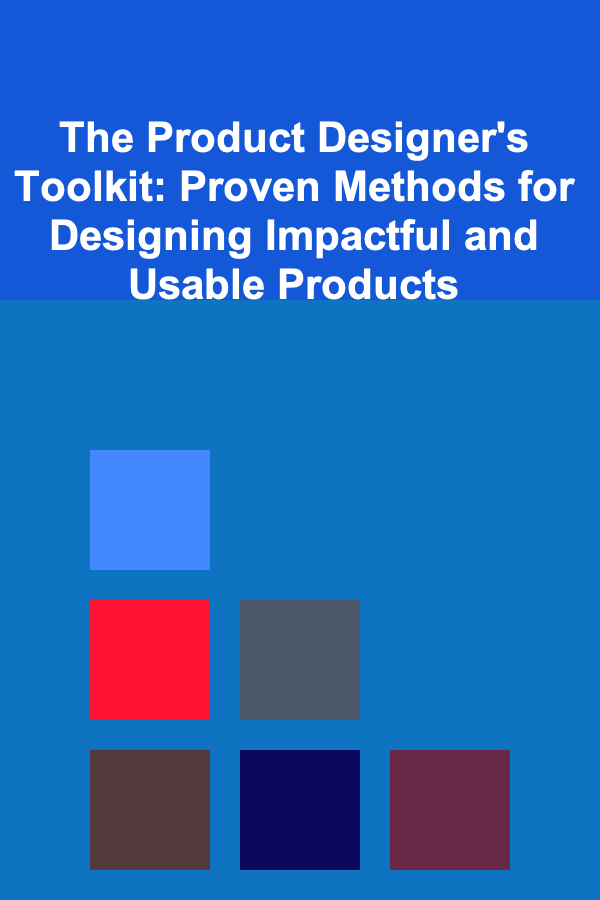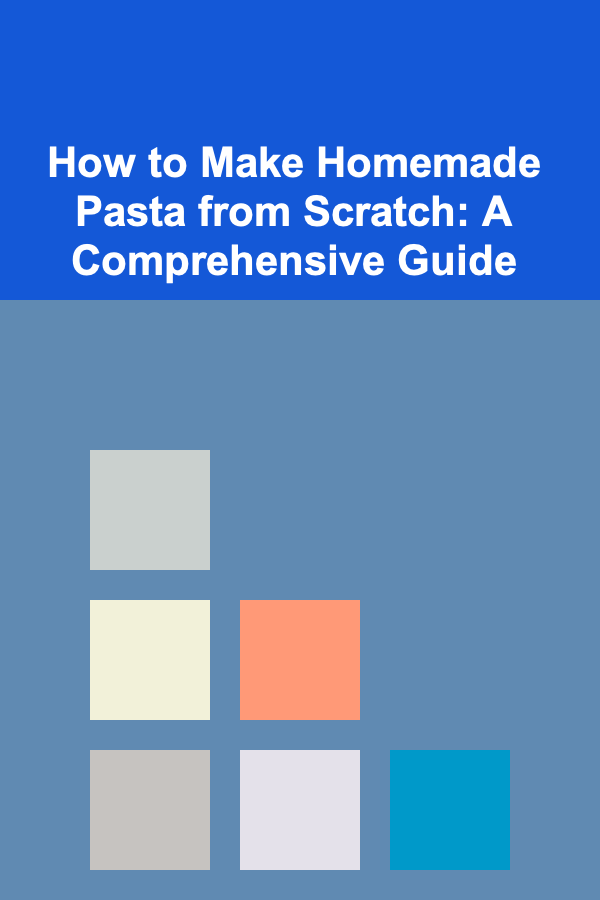
The Product Designer's Toolkit: Proven Methods for Designing Impactful and Usable Products
ebook include PDF & Audio bundle (Micro Guide)
$12.99$10.99
Limited Time Offer! Order within the next:

Product design is more than just making things look good; it's about creating solutions that solve problems, enhance user experience, and deliver tangible value. In the competitive world of product development, understanding the core tools and methodologies that successful designers use can help elevate your work and produce designs that truly make an impact. This actionable guide walks you through proven methods, essential tools, and best practices that can help you design usable, innovative, and successful products.
Understand the Problem Before You Design
The foundation of effective product design is deeply rooted in a comprehensive understanding of the problem you're solving. To design something truly impactful, you must be in tune with the needs, challenges, and desires of your target audience. Here's how to approach it:
a. Define the Problem
Start by clearly defining the problem. This might sound straightforward, but it's common to rush into a design without fully understanding the underlying issues. Use tools like problem statements and user stories to articulate the pain points and needs you're addressing.
- Problem Statement: A concise statement that describes the problem from the user's perspective.
- User Stories: These are short descriptions of a feature from the user's point of view, helping you focus on the user's needs and outcomes.
b. Conduct User Research
User research is a critical part of the discovery phase. It helps you gain insights into who your users are, their behaviors, and their pain points. Effective user research methods include:
- Interviews: Conduct one-on-one interviews with potential users to gather qualitative data.
- Surveys: Use surveys to collect quantitative data about user preferences, behaviors, and pain points.
- Observation: Watch how users interact with similar products or systems. This can reveal hidden challenges and opportunities.
- User Testing: Test your existing product or a prototype with real users to identify usability issues.
c. Market Research
Beyond understanding your users, it's important to explore the competitive landscape. What other solutions are out there? How does your product differ from or improve upon existing options? This helps identify your unique selling proposition (USP) and can reveal opportunities for differentiation.
Ideation: Generating Creative and Viable Ideas
Once you have a solid understanding of the problem, the next step is ideation. This is where creativity and innovation come into play. The goal here is to generate as many potential solutions as possible before narrowing down to the most viable options.
a. Brainstorming Sessions
Use brainstorming to generate a wide variety of ideas. Involve a diverse group of people to bring different perspectives to the table. Some useful techniques for brainstorming include:
- Mind Mapping: Start with the central problem and branch out to related ideas, features, and solutions.
- Sketching: Quick sketches can help visualize ideas and make them more tangible.
- Reverse Brainstorming: Instead of solving the problem, try to think of ways to make it worse. This can reveal solutions you wouldn't have considered otherwise.
b. User-Centered Design
Keep the user at the center of your ideation process. Use personas , journey maps , and empathy maps to guide your thinking. Personas are detailed profiles of your target users, while journey maps illustrate how users interact with your product across different stages.
c. Prioritize Ideas
Not all ideas are created equal. Use methods like Impact vs. Effort matrix to prioritize ideas based on their potential impact on the user and the effort required to implement them. This helps you focus on high-impact solutions that are feasible within your time and resource constraints.
Prototyping: Turning Ideas into Tangible Designs
Prototyping is a powerful tool for testing ideas and communicating design concepts. It allows you to visualize and refine ideas before building the final product. Prototypes range from low-fidelity (basic wireframes) to high-fidelity (interactive prototypes that resemble the final product).
a. Low-Fidelity Prototypes
At the early stage of design, low-fidelity prototypes are quick and cost-effective. Use tools like paper sketches, wireframes, or mockups to represent your ideas visually. These prototypes help you iterate quickly without investing significant resources.
- Wireframes: Simplified versions of your product's interface that outline the basic structure and flow.
- Mockups: More detailed representations that show how the final product might look.
b. High-Fidelity Prototypes
Once you've settled on a design direction, create high-fidelity prototypes that closely resemble the final product. These prototypes are interactive and help test the usability and functionality of your design.
- Tools: Popular prototyping tools include Figma, Sketch, Adobe XD, and InVision.
- Usability Testing: Conduct usability tests on high-fidelity prototypes to gather feedback from real users and identify usability issues before development.
User Testing: Validating and Refining Designs
User testing is an essential step in the product design process. It helps validate your design decisions and ensures that your product is usable and effective.
a. Types of User Testing
- Formative Testing: Conducted during the design process to gather feedback and refine ideas.
- Summative Testing: Happens after the product is built to assess its overall effectiveness and user satisfaction.
- A/B Testing: Present different variations of a design to users to determine which one performs better.
b. Usability Metrics
When conducting user tests, measure key usability metrics such as:
- Task Success Rate: The percentage of users who successfully complete a given task.
- Time on Task: How long it takes users to complete a task.
- Error Rate: The number of errors or mistakes users make while using the product.
- Satisfaction: Gather qualitative feedback on users' feelings and perceptions of the product.
c. Iterate Based on Feedback
Once you have gathered data from testing, analyze the results and refine your design accordingly. Don't be afraid to go back to the drawing board and make changes---design is an iterative process.
Visual Design: Enhancing Usability with Aesthetic Appeal
While functionality is critical, the visual design of a product plays a significant role in its usability and user experience. A visually appealing design can enhance the user's emotional connection with the product, making it more engaging and intuitive.
a. Consistency in Design
Consistency is key to creating a user-friendly interface. Use consistent colors, typography, and design elements throughout the product to guide users and make the experience more predictable.
- Design Systems: Establish a design system that defines the visual language of your product. This includes color palettes, typography styles, spacing, and component libraries.
- UI Kits: Use UI kits to ensure consistency and speed up the design process.
b. Accessibility
Ensure that your design is accessible to all users, including those with disabilities. This involves using high-contrast color schemes, providing text alternatives for images, and ensuring keyboard navigability.
- WCAG Guidelines: Familiarize yourself with the Web Content Accessibility Guidelines (WCAG) to make sure your designs are accessible to a broad audience.
c. Responsive Design
With the increasing use of mobile devices, it's crucial that your design works seamlessly across different screen sizes. Use responsive design principles to ensure that your product adapts to various devices and screen resolutions.
Collaboration and Communication: Working with Cross-Functional Teams
Product design doesn't exist in isolation. As a designer, you'll need to work closely with other team members, including product managers, developers, and marketers. Effective collaboration is key to creating a cohesive and successful product.
a. Cross-Disciplinary Communication
Regular communication with stakeholders ensures that everyone is aligned on the product vision, goals, and priorities. Use tools like Slack , Trello , and Asana to manage tasks and keep everyone on track.
b. Feedback Loops
Encourage a continuous feedback loop with team members throughout the design process. Early and frequent feedback can prevent costly mistakes and ensure the design meets user and business goals.
c. Developer Handoff
Once your design is ready for development, ensure a smooth handoff to the development team. Provide detailed specifications, design files, and prototypes to make the development process more efficient. Tools like Zeplin or Figma facilitate seamless handoff with developers.
Conclusion
Designing impactful and usable products requires a combination of creativity, empathy, and practical methodologies. By following a structured approach---from understanding the problem, ideation, and prototyping to user testing and collaboration---you can create products that not only meet user needs but also delight and engage users. The tools and methods outlined in this guide are just the beginning of your journey as a product designer. Through continuous learning and iteration, you can refine your design process and create products that leave a lasting impact.
Reading More From Our Other Websites
- [Weaving Tip 101] Best Methods for Adding Reinforced Edge Binding to Hand‑Woven Outdoor Curtains
- [Rock Climbing Tip 101] Flat vs. Downturned: Which Climbing Shoe Profile Is Right for Your Style?
- [Personal Care Tips 101] How to Create a Messy, Effortless Look with Hair Mousse
- [Personal Investment 101] How to Invest in Real Estate Crowdfunding
- [Beachcombing Tip 101] The Beachcomber's Guide to Identifying Rare Shells and Marine Finds
- [Home Security 101] How to Use Home Security Cameras with Cloud Storage for Seamless Monitoring
- [Personal Finance Management 101] How to Manage Finances for a Single Parent Household
- [Personal Care Tips 101] How to Choose a Perfume Based on Your Skin Type
- [Organization Tip 101] How to Incorporate Multi-Functional Furniture into Your Design
- [Personal Care Tips 101] How to Use Sunscreen When Swimming or Exercising Outdoors

How to Clean and Maintain Your Gutters to Prevent Damage
Read More
How to Prevent Car Break-ins in Your Driveway
Read More
Understanding Whales in Crypto Markets: A Deep Dive
Read More
How to Make Homemade Pasta from Scratch: A Comprehensive Guide
Read More
Effectively Managing Enlarged Pores: A Comprehensive Guide
Read MoreHow to Integrate Your Home Maintenance Tracker with Budgeting Apps
Read MoreOther Products

How to Clean and Maintain Your Gutters to Prevent Damage
Read More
How to Prevent Car Break-ins in Your Driveway
Read More
Understanding Whales in Crypto Markets: A Deep Dive
Read More
How to Make Homemade Pasta from Scratch: A Comprehensive Guide
Read More